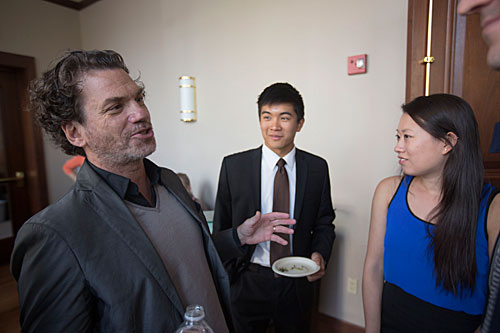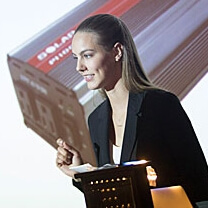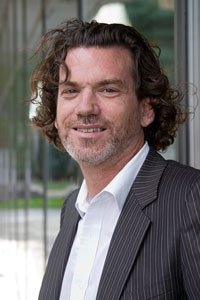News
Anna Ondaatje ’13 explains The Click. (Photo by Kris Snibbe, Harvard Staff Photographer.)
Imagine spraying the nape of your neck with a skin like substance that keeps you cool as you jog in the August heat. Imagine generating electric power with every step you take. Imagine stopping along the way to pick a container of refreshing water from a tree.
This is the kind of future that the students of “Engineering Sciences 20: How to Create Things and Have Them Matter” (ES20) are working to create. Sixteen students are enrolled in the annual spring course, offered by the Harvard School of Engineering and Applied Sciences (SEAS). In teams of three to five, they have imagined products designed to change the world. Each team presented its project at Oberon on Monday.
Class co-instructor David Edwards opened the presentations before about four dozen students and friends, saying that after an intense week it seemed fitting to start by talking of dreams of what could be.
Edwards also provided a peek at plans for the Lab Cambridge, part of the Idea Translation Laboratory, which is scheduled to open in 2014. The lab will be a permanent home for educational programs such as ES20, for cultural work, and for commercial enterprise exhibitions. The Idea Translation Laboratory is an international educational model spanning from Paris (at Le Laboratoire) to Singapore, Saudi Arabia to Minnesota, Cape Town to Cambridge.

David Edwards (from left) chats with Team Canary Paint’s Eric Lu ’14 and Melissa Niu ’13. (Photo by Kris Snibbe, Harvard Staff Photographer.)
Edwards kept his remarks short, giving time to four teams introducing their projects. Amanda Lu ’13, Ana Sofia Guerra Rodriguez ’15, Suvai Gunasekaran ’13, and Sharon Stovezky ’15 were the first presenters, as Team Smart Skin. The product, they explained, would be a breathable, elastic, spray-on that reacts with both the body and the environment. It would keep you cool during exercise, could be worn like a garment, and could be disposed of in a day or two.
Smart Skin, like all the ES20 projects, would have a humanitarian purpose: Used for disease control, they said as an image of a mosquito flashed on the screen, Smart Skin might eventually save lives. The students plan to file for a provisional patent for Smart Skin at the end of August.
Topics: Academics
Cutting-edge science delivered direct to your inbox.
Join the Harvard SEAS mailing list.
Scientist Profiles
David A. Edwards
Associate in Bioengineering




